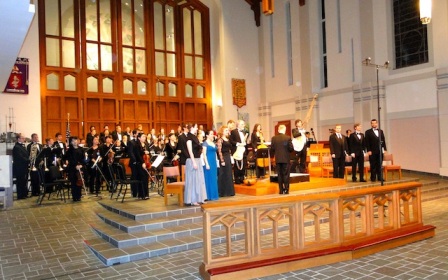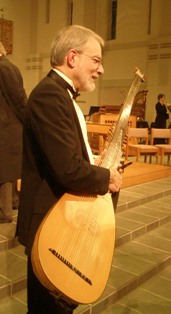
Monteverdi's 1610 Vespers led by Earl Rivers, Christ Church Cathedral, Nov. 21, 2010
|
It’s on to 500 for Claudio Monteverdi, the great composer who, like Bach and Handel, brackets the Baroque era (1600-1750). Except, as conductor Earl Rivers noted Sunday evening at Christ Church Cathedral, Monteverdi came at the beginning.
And what a beginning. In remarks before leading a 400th-anniversary performance of Monteverdi’s Vespers of 1610 with forces from the University of Cincinnati College-Conservatory of Music, Rivers called the 90-minute work “a pillar of the Baroque era” and “the core international repertory work of the Early Music movement.” It was a very special event indeed.
The performance began after a brief “show-and-tell” of the exotic instruments to be heard – lirone, theorbo, archlute, cornetto – and at just the right hour for Vespers (twilight) with light still filtering through the Cathedral’s high, stained glass windows. It was a superb performance by the CCM Chamber Choir, CCM Philharmonia Chamber Orchestra, student soloists and an array of Early Music guests. In all, there were 94 performers: 45 in the choir, 33 in the orchestra, 8 vocal soloists and 8 continuo players.
Christ Church has beautiful acoustics, warm but not overwhelming. The lowest string on Michael Leopold’s six-and-a-half-foot theorbo (a bass lute) sounded clearly throughout the Cathedral, as did the gentle voice of Rodney Stucky’s Baroque guitar.
Leopold, who
traveled from Milan, Italy to participate in the concert, is one of the Early
Music practitioners who formed the continuo group (the musicians who perform the
“continuing” bass line throughout a piece of Baroque music and improvise harmonies
above it). Joining Leopold and Stucky (archlute and Baroque guitar) were Vivian
Montgomery (harpsichord and organ), Elizabeth Motter (harp) and Annalisa Pappano
(lirone, a relative of the viola da gamba). All are eminent in Early Music
circles. Montgomery commutes from Boston
to teach at CCM. Motter free lances and
teaches in the Cincinnati area. Pappano
and Stucky are co-directors of CCM’s Early Music Lab. Pappano is also founder and artistic director
of the Cincinnati-based Early Music ensemble Catacoustic Consort.

Joining the orchestra were cornettists Kiri Tollaksen of Ann Arbor, Michigan and Shawn Spicer of Toronto (a cornett has the body of a recorder and the sound of a trumpet).
Student members of the continuo group, all from CCM, were Sujin Kim (organ), Micah Fusselman (viola da gamba) and Andrew Williams (double bass), all very accomplished on their instruments.
Monteverdi’s 1610 Vespers manifests a wide spectrum of Baroque styles. Its 13 movements alternate Psalms from the Roman Catholic liturgy with sacred motets, instrumental music and a hymn to the Virgin Mary. It concludes with the traditional Magnificat. There are Renaissance-style, polyphonic movements and “modern” song-and-accompaniment movements, showing a mix of sacred and secular influence. Gregorian chant is a unifying element.
The diversity of the Vespers is apparent from the first movement, a verse of chant followed by a traditional liturgical response, clearly derived from the introduction to Monteverdi’s opera “L’Orfeo.” The sound was magnificent, with the four trombonists and two cornettists standing at the rear of the orchestra.
Psalm 109, “Dixit Dominus,” for six-voice choir and orchestra, showed nimble counterpoint and remarkable continuity between the many changes of meter that characterize the Vespers. “Nigra sum,” a song/motet from the biblical “Song of Songs” exemplified the modern aspect of the work. Tenor Ryan C. Connelly made it the more ravishing because of his subtlety of expression. “Pulchra es” for two sopranos, also from “Song of Songs,” was similarly touching. Sopranos Kelly Ballou and Abigail Santos sang without vibrato. Leopold heightened the effect in both movements with his sensitive improvisation on the theorbo.
Psalm 122, “Laetatus sum,” for six-voice choir, orchestra and the full continuo, made a powerful impression. It also showed off the Chamber Orchestra strings, who, coached by violinist Manami White, violin/viola instructor at Xavier University, played in convincing Baroque style, vibrato-less, with sweeping strokes of the bow. “Duo Seraphim” was one of the loveliest numbers on the program. It began with tenors Andrew Penning and Connelly, adding a third, Ian Ramirez, as the text invoked the Trinity. The three singers built excitement into the text with their intricate, imitative coloratura (on some of the longest syllables one is likely to hear). Members of the continuo reflected this in their improvisations, Montgomery moving from organ to harpsichord on “Sanctus” to add distinctive color and projection.
Psalm 126, “Nisi Dominus,” for ten-voice choir (no less), was a challenge happily met by the Chamber Choir. “Audi coelum,” a motet for two tenors in echo-style, followed, with Penning in the chancel and Connelly singing from the balcony. The effect, especially as embroidered by the continuo and reinforced by the Choir, was entrancing. The first half of the concert closed with “Lauda Jerusalem,” a psalm of praise (No. 147) for double choir.
The second half was quite different from the first. It began with “Sonata sopra Sancta Maria ora pro nobis,” one of the earliest pieces of orchestral music, Rivers said. Monteverdi gave it the character of Vespers music with the addition of a chant melody sung over the instruments by the women of the Choir. Violinists Scott Jackson and Gi Yeon Koh stood for some vibrant solos, enhancing the overall effect.
Each stanza in the Marian hymn “Ave Maris Stella,” for double choir and soloists, was treated differently, sometimes with choir alone, sometimes with mezzo-soprano Ivy Walz (“Monstra te esse matrem”) or bass Timothy Bruno (“Virgo singularis”). All sang with beauty of sound and ensemble clarity.
As in the Vespers liturgy, the work closed with a Magnificat. This 20-minute movement summed up the brilliance of the entire performance. There were different configurations of solo and choir on each verse, always threaded with Gregorian chant. Rivers led masterfully as he did all evening, with or without a baton, with careful attention to the constantly shifting meters and differences in expression. Clearly, he loves this music and was excited to share it, not only with his charges at CCM, but with anyone appreciative of the very finest in choral and choral/ orchestral music.
In addition to
his post at CCM, Rivers is director of music at Knox Presbyterian Church in
Hyde Park. He recently stepped down as
music director of the Vocal Arts Ensemble after 20 years of distinguished
leadership. Whether it’s old music
(Monteverdi, Bach), new music (Penderecki, Tan Dun), or somewhere in between
(Berlioz, Britten), Earl Rivers regularly brings the best there is to
Cincinnati.
See also "Quadricentennial at Christ Church" in "Features" on this site. http://www.musicincincinnati.com/site/features/Quadricentennial_at_Christ_Church.html